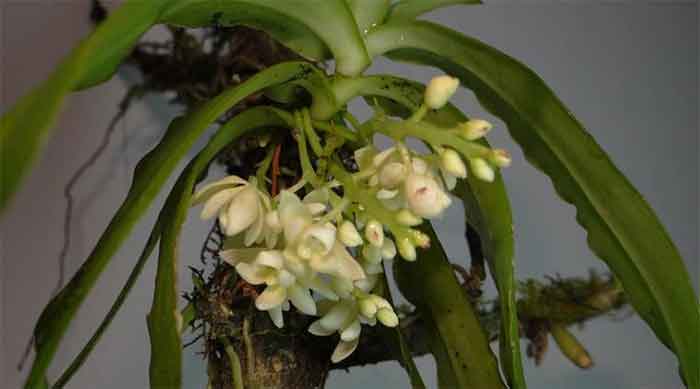
We lived in Shillong in Meghalaya for two years when my father was posted there with the Indian Air Force. That is where we learnt so much about India’s rare orchids which grew quite happily in the jungles around. In Fact there was a beautiful Orchidarian which was close to our home off Laitumkhrah in the busy downtown area. The house overlooked the defunct Race Course and the beauty of orchids that grew quite effortlessly made us as a family enjoy them for the years we spent there. However my father was always concerned that the orchids were being harvested indiscriminately and sold to visitors at a pittance.
According to WWF, India’s orchids are under pressure from illicit harvesting and exploitation for illegal trade. Of the vast diversity of 1256 orchid species recorded in India, 307 are endemic to our country, and only 11 species are protected under the Wildlife (Protection) Act, 1972.
In order to highlight the threat to orchids from illegal trade and to increase the capacity of the enforcement officials to identify the 11 protected orchid species, TRAFFIC and WWF-India have developed a poster on the legally protected orchid species whose trade or any other form of utilisation is prohibited.
The poster was released on 7th September, ahead of Save the Himalayas Day since India’s Himalayan region is home to many orchid species, with Eastern Himalayas exhibiting maximum orchid diversity.The new poster, “Legally Protected Orchids of India” combines beautiful illustrations of orchid flowers and related information and will aid enforcement agencies in identifying the orchid species in the illegal trade. The poster will also help to create awareness about orchids among students, educators and the general public.
Since orchids are highly sensitive to the climatic changes in their habitat and have extensive, interconnected symbiotic relationships with organisms like insects, plants, and fungi, their presence is a positive indicator of the healthy ecosystem and the biodiversity of their habitat. Orchids play a vital ecological role by constituting a crucial element of any forest ecosystem through a highly complex mutual relation with other organisms.
Orchids are one of the most threatened flowering plants in the world. Illegal harvesting and overexploitation pose a severe threat with species like Renanthera spp and a few slipper orchids such as Cypripedium, Paphiopedilum, showing significant impact from the practice.
Orchids are illegally collected and traded for ornamental plants, traditional medicine, and food10. The increasing demand for it is leading to unsustainable harvesting practices.
Orchids like Eulophia dabia and Dactylorhiza hatagirea populations are succumbing to overharvesting.
Crepidium acuminatum, Habenaria edgeworthii and Habenaria intermedia are collected from the wild for their medicinal use. They are used in making Chyawanprash, a popular dietary supplement in India. Protected species of orchids such as Blue Vanda, Ladies Slipper have been seized in India with seizures reported in West Bengal and Assam and by Department of Revenue Intelligence.
Mr Ravi Singh, Secretary General & CEO, WWF India, said, “Orchids are found throughout the Himalayan region of India. Time and again, new orchid species are discovered in the region, reflecting the hidden trove of floral treasures of the Himalayas. Conservation measures in the Himalayan region are key to conserving myriad species, including orchids and the ecosystems they represent”.
Dr Merwyn Fenerandes, Coordinator, TRAFFIC’s India Office, further added, “Such vast orchid diversity, unsustainable harvesting practices and illegal trade coupled with limited protection measures and lack of awareness makes the future of orchids a serious concern. By issuing this identification poster, our joint efforts to stop the illegal orchid trade gets a strong and considered boost.”
In India, orchids are illegally collected from the wild and traded as ornamental plants, for use in traditional medicine and also consumed as food. The rising demand for orchids for various purposes leads to unsustainable harvesting practices. Globally this second-largest family of flowering plants has some of the most prized and traded flowers. In India, protected species of orchids such as Blue Vanda and Ladies Slipper have been found in wildlife seizures.
Orchids are one of the most prized ornamental plants traded as flowers and potted plants globally. The term “orchid” has been derived from the Greek word “orchis,” and taxonomically, placed in the order Asparagales under the Orchidaceae family. Orchids belong to the second- largest family of flowering plants, and there are more than 29,500 orchid species worldwide.
IUCN Global Red List has assessed about 1641 orchid species (July 2020) of which 747 are categorised as ‘Threatened’ with 197 listed as ‘Critically Endangered’. India is home to 1,256 species belonging to 155 genera. Of these, 307 species are endemic to the country.
Fossil evidence suggests that orchids emerged over 80 – 100 million years ago.
Orchids have the smallest seeds amongst the flowering plants in the world and they are very difficult to grow requiring unique micro-habitats.
- About 8% of all flowering plants are orchids.
- Orchid species have been recognised for their medicinal properties in the ancient Indian therapeutic system of Ayurveda.
- In India, Arunachal Pradesh is home to about 40% of orchid species in the country and is often referred to as the ‘Orchid Paradise of India.’
Dr Marianne De Nazareth
( Adjunct faculty MCC, JNC and SJCC and freelance Science and Environment journalist)
















































